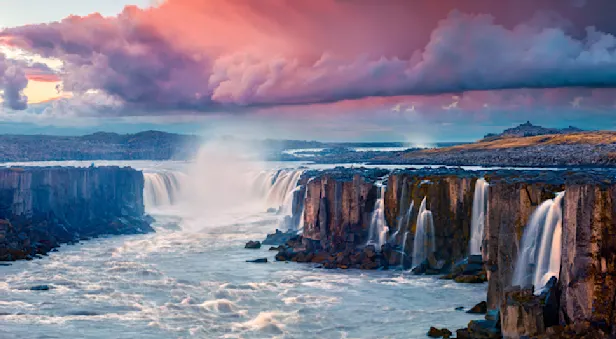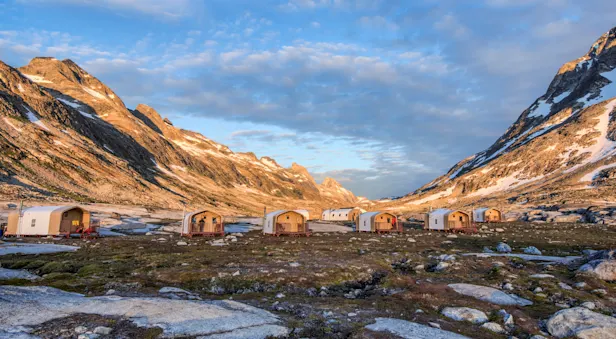
Know Before You Go
Humpback Whale Facts | Iceland Wildlife Guide
Physical Characteristics
The humpback whale belongs to the family of rorquals, a group of baleen whales that includes blue, fin, minke, sei and Bryde’s whales. Humpback females are larger than males, measuring 45 to 50 feet in length and weighing up to 40 tons. The most distinctive features of humpback whales are the size and form of their flippers, fluke shape and coloration, and their dorsal fin shape.
The humpback whale has long flippers which can extend to almost a third of their body length. The flippers have large knobs on the leading edge and are mostly white in color. The butterfly-shaped flukes of the tail are scalloped on the trailing edge and have a white-gray pattern unique to each individual. The dorsal fin is either sharply curved or triangular and is commonly humped in shape, from which it derives its name. The name “humpback” also comes from the curving motion of its rounded back while diving. Parasitic sea lampreys will sometimes attach themselves to the whales, marking the humpbacks skin with oval, white scars.
The humpback whale has the thickest blubber of any baleen whale its size, beside the blue whale. The thickness of its blubber depends on a whale’s age, physiological health, and the time of year. The cerebellum of the humpback whale makes up about 20 percent of the total weight of the brain. The humpback’s olfactory system is severely compromised—they may not possess a sense of smell. Their eyes are small and adapted to withstand water pressure, and their external auditory passages are narrow, leading to a minute hole on the head not far behind the eye.
Habitat
Humpbacks are found in tropical and polar waters within the Arctic, Pacific, and Atlantic Oceans, in addition to the Bering Strait and Antarctica. During migration, their range extends from the coasts to the deep ocean.
Humpback whales are made up of different populations, including two stocks in the North Pacific Ocean, two in the North Atlantic, and seven stocks in the southern oceans. These stocks are generally isolated, but at rare times will interchange.
Feeding Habits
Humpbacks are highly mobile and opportunistic feeders. During the summer they feed on both plankton and large schools of fish. In order to feed, a humpback will take food and water into its mouth. They have 14 to 35 ventral grooves which allow their throat to expand and take in their food. They then close their mouth and press out the water. A whale’s baleen plates catch and then swallow their food thanks to their tongue. Because of this process, humpbacks are classified as “swallowers” and not “skimmers.”
Humpbacks practice five main feeding practices depending on the type and quality of food available. In the flick feeding method, a whale will lie on the surface of the water, swimming in a circle and striking their tail flukes. This motion creates a ring of foam surrounding their prey. They proceed to dive underneath the foam ring and reemerge in its center, their mouth open to swallow the food. Another method is referred to as “lunging.” In this technique, the whale feeds by swimming vertically up through aggregations of plankton or fish. This occurs only when food is abundant.
Some whales practice a technique known as “bubble netting,” where underwater exhalation creates bubble clouds and bubble columns. This inter-connected mass of bubbles is created by a single underwater exhalation, which actually herds a mass of prey together. It is thought that humpbacks feed underwater, after which the whales gradually ascend to the surface within a bubble cloud. After a number of blows from its blowhole, and several dives close to the ocean’s surface, the feeding will resume. This behavior may assist in the detection of food, or help to confuse and immobilize prey.
Behavior
Humpback whales migrate from northern to southern latitudes in accordance with the climatic cycle. Its migration is also connected to reproduction and feeding. Humpbacks will feed in cold waters during the spring, summer, and fall, journeying to shallow, tropical banks in the winter. When a body of land blocks their direct migration route, the whales will swim around it through coastal waters.
Perhaps the most interesting behavior of humpback whales is their practice of “singing” long, complex songs. Scientists have discovered that whales in a specific population sing the same song, but the songs of each population are diverse. The average whale song is 10 to 20 minutes in length and repeats for several hours. The song will gradually adjust its tune each year. It is thought that these songs may be associated with mating and that all songs are produced by males. Whales are thought to develop their songs in their breeding grounds before they begin migrating.
Humpbacks may dive up to 20 to 23 feet for about 15 to 20 minutes. While submerging for short dives, the tail flukes do not lift and blows are irregular. During longer dives, the flukes will lift and blow regularly, surfacing between dives for around four minutes. Swimming speed may reach 17 miles-per-hour; during migration, however, it averages between two and nine miles-per-hour. Whales with calves swim the slowest, while lone whales travel faster than those in groups.
Predators
Besides humans, humpback whales have few predators. They are occasionally threatened or killed by orcas, and sharks may eat their carcasses after death.
Reproduction
Humpback whales reach sexual maturity at four to five years of age. The length of a male’s penis may be a sign of sexual maturity, however, puberty may happen up to a year before sexual maturity. The testes of sexually mature males increase in size, as does the rate of spermatogenesis during mating season. Sexually mature females maintain a constant ovary weight. As ovulation begins, the Graafian follicles on the surface of the ovary will become larger. Females ovulate about once per breeding season.
There have been few observations of humpback copulation. Humpbacks appear to engage in a polygamous mating system, with the male competing aggressively for estrous females. The breeding season occurs during the winter in tropical waters. The male and the female begin by swimming in a line, and then proceed to fluke their tails, flip, and roll. They both then dive and breach vertically, there undersides almost touching. The pair emerges from the water to a point below their flippers, then fall back onto the surface of the water together. Once fertilization has taken place, the gestation period lasts 11 to 11½ months, during which time the embryo grows approximately seven to fourteen inches per month.
Calves
Humpback calves are born in the warm, tropical and subtropical waters of each hemisphere. The newborns usually measure 13 to 16 feet long and are suckled by their mothers for about five months. A mother’s nutrient-rich milk contains large quantities of fat, lactose, and protein. Males do not care for their young. Mating typically occurs every two years. However, it can happen twice in three years, which may result in a longer lactation period. If a female becomes pregnant soon after birthing, it is possible for lactation and pregnancy to happen at the same time.
“Escort” whales, mostly males, will sometimes travel with groups of mothers and calves. They will become hostile to other humpback whales that attempt to approach the group, sometimes blowing bubbles in a kind of protective “screen”. Other protective behaviors include lobtailing, lashing their tail horizontally, and thrashing their body. This aggressive behavior may also be demonstrated to ships that come too near the group.
See Humpback Whales on These Trips

Iceland: Circling the Land of Fire & Ice
An immersive journey into the rugged grandeur of a land sculpted by intense geological forces. Make a full loop around Iceland on the most comprehensive nature adventure this compact country has to offer.































